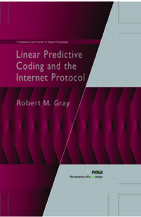A Survey of Linear Predictive Coding: Part I of Linear Predictive Coding and the Internet Protocol
By Robert M. Gray, Department of Electrical Engineering, Stanford University, USA, rmgray@stanford.edu
Abstract
Linear prediction has long played an important role in speech processing, especially in the development during the late 1960s of the first low bit rate speech compression/coding systems. The approach, which eventually became known as linear predictive coding (LPC), coincidentally came to fruition at the right time to be adopted as the speech compression technique in the first successful realtime packet speech communication through the nascent ARPAnet in December 1974 — the ancestor of voice over the Internet Protocol (IP) and, more generally, of realtime signal processing through the Internet. This first part of a two part monograph on LPC and the IP provides a tutorial overview of linear prediction and its application to speech coding. A variety of viewpoints provides background and context for the second part, which comprises a technical and personal history of LPC, its use in the first packet speech demonstrations, and many related stories of the early applications of LPC and the prehistory of the Internet.
Linear Predictive Coding and the Internet Protocol
In December 1974 the first realtime conversation on the ARPAnet took place between Culler-Harrison Incorporated in Goleta, California, and MIT Lincoln Laboratory in Lexington, Massachusetts. This was the first successful application of realtime digital speech communication over a packet network and an early milestone in the explosion of realtime signal processing of speech, audio, images, and video that we all take for granted today. It could be considered as the first voice over Internet Protocol (VoIP), except that the Internet Protocol (IP) had not yet been established. In fact, the interest in realtime signal processing had an indirect, but major, impact on the development of IP. This is the story of the development of linear predictive coded (LPC) speech and how it came to be used in the first successful packet speech experiments. Several related stories are recounted as well. The history is preceded by a tutorial on linear prediction methods which incorporates a variety of views to provide context for the stories. This part is a technical survey of the fundamental ideas of linear prediction that are important for speech processing, but the development departs from traditional treatments and takes advantage of several shortcuts, simplifications, and unifications that come with years of hindsight. In particular, some of the key results are proved using short and simple techniques that are not as well known as they should be, and it also addresses some of the common assumptions made when modeling random signals. Linear Predictive Coding and the Internet Protocol is an insightful and comprehensive review of an underpinning technology of the internet and other packet switched networks. It will be enjoyed by everyone with an interest in past and present real time signal processing on the internet.

Companion
A History of Realtime Digital Speech on Packet Networks: Part II of Linear Predictive Coding and the Internet Protocol , Foundations and Trends® in Signal Processing, Volume 3, Issue 4 10.1561/2000000036